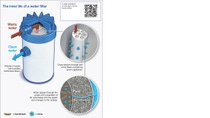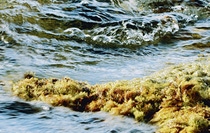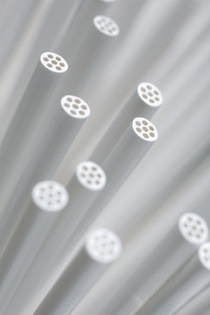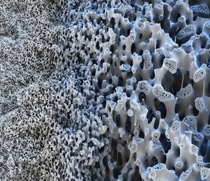News & Media
Ultrafiltration creates clear conditions
Multibore® membranes from the BASF subsidiary inge® improve water treatment
- Clean water
Filter membranes remove suspended solids and microorganisms. - Fine capillaries
Arrangement of filter fibers stabilizes the membrane. - Optimized plastic
Easier cleaning of filters prolongs membrane lifetime.
Seas and oceans are the biggest water reservoirs on Earth. Since decades sea water is turned to drinking water by desalination in large scale. In Ghana, West Africa, a modern desalination plant is currently being established to produce up to 60,000 cubic meters of drinking water per day - enough to supply half a million people. In this plant ultrafiltration membranes made by the BASF subsidiary inge® play an important role: They are used to pretreat the salt water in order to optimize the actual desalination and to protect the downstream salt filters from contamination. These salt filters operate according to the reverse osmosis principle - hereby the water diffuses as individual molecules through the sensitive membrane. As high pressure of up to 80 bar is required for this process, the pre-purification by means of ultrafiltration additionally contributes to the limitation of the energy input.
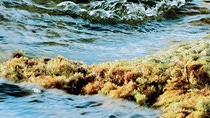
The water taken out of the sea is forced under pressure through the very fine-pore Multibore® membranes and can pass through them, while undesired substances such as sand, clay, algae and even pathogenic germs are intercepted. At first glance, the ultrafiltration membranes look like thin white tubules, but the cross-section reveals their complex inner life: The fiber contains seven capillaries into which the raw water runs. The walls of the capillaries have tiny pores with a diameter of about 20 nanometers - this is 500 times thinner than a filament of a spider's web. All the particles larger are retained here by the membrane. Only the purified water passes through the pores into the plastic fiber and emerges again on the outside of the fiber.
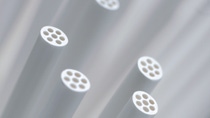
Production of the membranes requires extensive know-how and experience. "The challenge is to create pores during the production process that are small enough and evenly distributed over the membrane surface," explains Dr. Nicole Janssen, Laboratory Team Leader at Performance Materials Research. Together with her team, she is optimizing the conditions and the starting material from which the membrane fibers are manufactured: the BASF plastic Ultrason® E, a polyethersulfone. "We can now adjust the Ultrason® solution and the process so accurately that the membranes offer dependable filter performance."
For the filters to work reliably in practice, however, not only the size and distribution of the pores have to be correct, the fibers also have to be resistant. This is ensured by the honeycomb structure inside the fibers designed by the experts of the BASF subsidiary inge®. "The arrangement of the seven capillaries in the supporting structure makes the fiber mechanically stable and thereby resilient," explains Martin Heijnen, Head of Membrane Development at inge®, who adds: "This protects the membranes against fine cracks through which otherwise bacteria or viruses could pass."
In a filter plant through which, for example, the sea water in Ghana will be pumped, the membrane fibers are bundled together in white plastic cylinders. The ends are stuck to the housing with epoxy resin. During operation, the lower surface is sealed so that the capillaries are only open at the top. Here the raw water is pumped in at a pressure of about 0.5 bar. The only path it can take from here is through the pores in the internal capillary walls of the fibers - and out again as clean water on the outside.

Over time, the residues collect in the capillaries. To ensure that the water can penetrate this so-called filter cake, the water pressure has to be increased. This requires large amounts of energy and causes stress to the membranes. The filter system is therefore cleaned regularly every one to two hours by reversing the water flow: Clean water is briefly forced from outside into the fibers and rinses the filter cake out of the capillaries.
Nevertheless, blockages in the pores or sticky substances like sugar or proteins may still remain behind. These are removed chemically at longer intervals, for example using sodium hydroxide, acid or hypochlorite. In time, however, oxidizing agents can attack the plastic Ultrason® E. The material expert Janssen and her colleagues want to improve this situation. For example, they are working on making the filter surface of the capillaries more hydrophilic, in other words more water-loving. In this way, it would be more difficult for the contaminants to be deposited. This would make cleaning easier and chemical cleaning steps would also be reduced. “Membrane service time and lifetime are thereby prolonged,” adds Janssen. These improvements would not only be useful for the pre-cleaning of sea water but also for the processing of drinking water or the treatment of waste water.
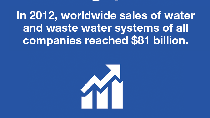
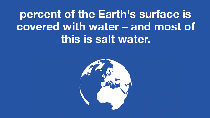

Source: BASF magazine "Creating Chemistry", issue 3/2013
Interview with Bruno Steis, Chief Executive Officer of inge GmbH

Is the production of water filters a growth segment?
Water is not only vital for our survival as humans, but is also used in almost all industrial processes. Natural water resources are being constantly depleted. Population growth and industrialization are exacerbating this trend. Moreover, the increasingly scarce water resources are being polluted by contaminated waste water. I am therefore convinced that the demand for our filters will continue to increase in future.
In which fields of application are the products of inge GmbH particularly in demand?
Our filters can be used for all kinds of water treatment. Their range of uses extends from the small household treatment plant to the water supply of entire cities or industrial applications, such as sea water desalination plants or supplying process water to steel production facilities.
Do you expect particularly strong growth in certain regions of the world?
The most important growth markets for us are Asia, especially China, where population growth and expanding economic performance will be accompanied by a great increase in water demand. The focus is also on the entire Middle East because of its lack of drinking water, where our technology is being used, for example, in the construction of large sea water desalination plants.

Ultrafiltration as central element of modern drinking water treatment
One of the most modern waterworks along the river Ruhr is jointly operated by the two municipal utilities of the towns Menden and Fröndenberg located on opposite sides of the river. With a multistage filtration process, the facility can process up to 600 cubic meters of raw water per hour into high-quality drinking water. The river water of the Ruhr has already passed through sand filters and the subsoil before undergoing mechanical pre-filtration. When all coarser constituents have been removed, the water then enters a system of ultrafiltration membranes from BASF subsidiary inge®.
This ultrafiltration is followed by three further steps that assure the high quality of the drinking water from the Ruhr: An activated charcoal filter extensively removes any organic trace materials such as medicinal product residues, the flat bottom degassers then deacidify the water, and irradiation with ultraviolet light provides the final disinfection. Other modern treatment facilities with the innovative Multibore® membranes as their central element are operating, for example, in the historical city of Trier which uses the water from a dam, and in Männedorf in Switzerland, where surface water is also fed into the drinking water supply.
Water Solutions from BASF
Know-how on membrane material is considered to be the key success factor for future innovations in polymer membranes. Since the acquisition by BASF in 2011 inge® has access to the know-how of the BASF polymer experts and expands as a growth field the offering of BASF's Water Solutions business worldwide. BASF provides a comprehensive and in its industry unique range of water treatment chemicals used for drinking and waste water treatment, desalination and industrial water treatment. The high performing products are manufactured around the globe in world-scale, state-of-the-art production plants. This makes BASF a reliable partner to serve the needs of the water industry.

